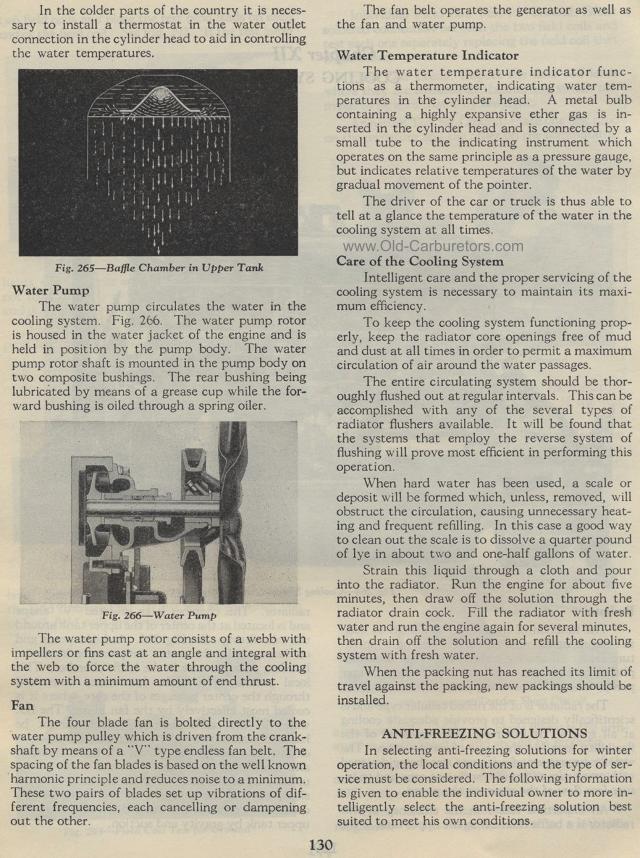In the colder parts of the country it is necessary to install
a thermostat in the water outlet connection in the cylinder head
to aid in controlling the water temperatures.
Fig. 265— Baffle Chamber in Upper Tank
1935 Chevy Water Pump
The water pump circulates the water in the cooling
system. Fig. 266. The water pump rotor is housed in the water jacket
of the engine and is held in position by the pump body. The water
pump rotor shaft is mounted in the pump body on two composite bushings.
The rear bushing being lubricated by means of a grease cup while
the for-ward bushing is oiled through a spring oiler.
The water pump
rotor consists of a webb with impellers or fins
cast at an angle and integral with the web to force the water through
the cooling system with a minimum amount of end thrust.
Fan
The four blade fan is bolted directly to the water pump pulley
which is driven from the crank-shaft by means of a "V" type
endless fan belt. The spacing of the fan blades is based on the
well known harmonic principle and reduces noise to a minimum. These
two pairs of blades set up vibrations of different frequencies,
each cancelling or dampening out the other.
130
The fan belt operates the generator as well as the fan and water
pump.
Water Temperature Indicator
The water temperature indicator functions as a thermometer, indicating
water temperatures in the cylinder head. A metal bulb containing
a highly expansive ether gas is inserted in the cylinder head and
is connected by a small tube to the indicating instrument which
operates on the same principle as a pressure gauge, but indicates
relative temperatures of the water by gradual movement of the pointer.
The driver of the car or truck is thus able to tell at a glance
the temperature of the water in the cooling system at all times.
Care of the Cooling System
Intelligent care and the proper servicing of the cooling system
is necessary to maintain its maxi-mum efficiency.
To keep the cooling system functioning properly, keep the radiator
core openings free of mud and dust at all times in order to permit
a maximum circulation of air around the water passages.
The entire circulating system should be thoroughly flushed out
at regular intervals. This can be accomplished with any of the
several types of radiator flushers available. It will be found
that the systems that employ the reverse system of flushing will
prove most efficient in performing this operation.
When hard water has been used, a scale or deposit will be formed
which, unless, removed, will obstruct the circulation, causing
unnecessary heating and frequent refilling. In this case a good
way to clean out the scale is to dissolve a quarter pound of lye
in about two and one-half gallons of water.
Strain this liquid through a cloth and pour into the radiator.
Run the engine for about five minutes, then draw off the solution
through the radiator drain cock. Fill the radiator with fresh water
and run the engine again for several minutes, then drain off the
solution and refill the cooling system with fresh water.
When the packing nut has reached its limit of travel against the
packing, new packings should be installed.
ANTI-FREEZING SOLUTIONS
In selecting anti-freezing solutions for winter operation, the
local conditions and the type of service must be considered. The
following information is given to enable the individual owner to
more intelligently select the anti-freezing solution best suited
to meet his own conditions.
Fig. 266— Water Pump
 |
